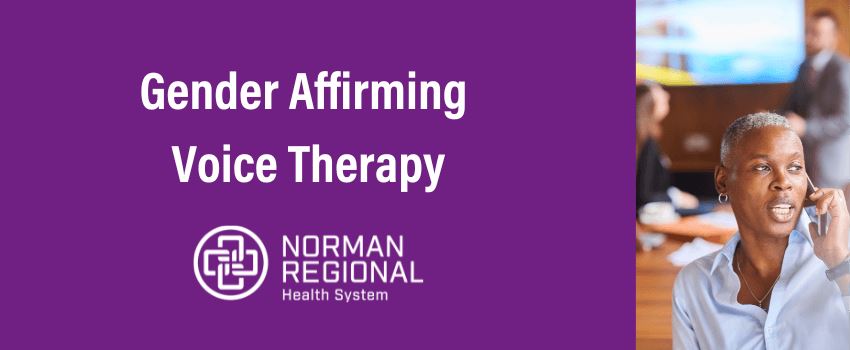Gender Affirming Voice Therapy
- Category: Educational
- Posted On:

Norman Regional’s speech language pathologists are helping patients find their authentic voice with gender-affirming voice therapy. Through personalized sessions, the therapists help patients align their voice with their gender identity. The goal is to meet the patient’s functional voice needs without causing strain or injury to the vocal cords. Therapists say the treatment can have a profound impact on the patient’s life, helping them feel more confident and more comfortable when communicating with others.
“The most common case for this type of speech therapy is when an individual is transitioning to male, female or non-binary and they want their voice to reflect the gender they are transitioning to. Part of their transition process includes sounding the way they wish to be identified, which could be more masculine, more feminine or androgynous,” said Mariah Hartzell, MS, CCC-SLP, a speech language pathologist with Norman Regional’s Physical Performance Center. “While this is the most common use gender affirming voice therapy can be applied to any individual that wishes to sound more like their preferred gender identity.”
Ways a voice can communicate gender
A common misconception about the way a voice can communicate an individual’s gender is that it can be achieved through raising or lowering pitch alone, but there is much more that goes into gender affirming voice therapy than that including:
- Vocabulary, politeness, directness, emotional expression
- Articulation/pronunciation
- Length of words/sentences
- Resonance of speech
- Voice quality
- Non-verbal cues such as, eye contact, facial expressions and posture
Gender affirming voice therapy is patient-centered
This type of therapy is by nature highly individualized, so each of the above aspects of an individual’s voice may be prioritized differently depending on what goals an individual sets for themselves.
“We work with our patients and want to be a partner for them in their goal setting since it is their voice we are working to adapt,” said Mariah Hartzell. “From a technical perspective, we use an app called Voice Tools that measures the frequency of our patient’s voices during conversation and we can compare that to the average frequency ranges of a feminine (200-300 hertz), masculine (80-150 hertz) and androgynous (160-180 hertz) voice. Anybody can change the frequency of their voice, but what this therapy seeks to accomplish is making the desired voice come naturally through practice, rather than something the patient has to think about and put effort into.”
Norman Regional prioritizes diversity, equity and inclusion in our community and just like the rest of the health system, our speech language pathologists including Mariah Hartzell, MS, CCC-SLP, Chelsey Shimanek, MA, CCC-SLP, Taylor Stewart, MA, CCC-SLP, and Emily Sullivan, MS, CCC-SLP, who will be seeing patients at Norman Regional Nine later this year, all work to create a welcoming and judgement-free environment for their patients. We also encourage patients to bring a family member, friend or anybody else with them to their therapy if it helps them feel more comfortable.
If you are interested in learning more about gender affirming voice therapy and speech language pathology, please visit our outpatient rehabilitation page or call the Physical Performance Center at 405-447-1571.



.png)